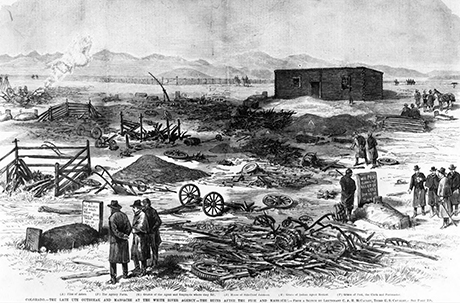This excerpt is found on our biography page for Goldstein and specifically for Isaac Goldstein. It deserves a spot on the Colorful Conflicts section for its general historical significance as well as for its tie to Jews in Leadville.
Isaac Goldstein arrived in Leadville on a mission: To find his wife, Rebecca, who had been declared dead by the United States government, the result of a renegade Ute Indian attack. It is unclear when Rebecca passed through the region, but reportedly she had gone to San Francisco to visit her brother who had been working as a miner in the Northern California gold fields. On her return trip, Rebecca’s party was ambushed by a band of Utes somewhere in Northeastern Utah. Isaac did not believe that Rebecca had been killed, [1] and with good reason; most Ute factions were peaceful when treated respectfully, and often took women and children hostage in conflicts, while only exacting violence on combatants. [2]
Isaac came to Leadville in the summer of 1879 as a peddler [3] and quickly employed that trade within the Indian agencies in the area as a tool for gathering information on Rebecca’s whereabouts. Difficulties would arise when Isaac went trading at the White River Indian Agency located about 20 miles north of Leadville near the settlement of Red Cliff. [4] Nathan Meeker, originally sent to Colorado as a newspaper man at the behest of his employer, Horace Greeley. Meeker lived amongst the Utes at a time when Colorado Governor Fredrick Walker Pitkin was demanding that the Utes assimilate to an agrarian lifestyle or relocate to the Indian Territory. Pitkin believed that Meeker was the man to help the local Ute, Chief Johnson, convince his people to make the transition. Chief Johnson refused to comply and on September 28, when Isaac Goldstein arrived at the agency camp to conduct business, relations between the Utes and the agents were on the verge of a violent altercation. [5] Meeker had already called for army reinforcements, [6] and was awaiting their arrival from Wyoming in hopes to regain control of Chief Johnson, by force if necessary.
On September 29, 1879, Utes under the command of Chief Johnson, attacked the agency, killing all ten employees, Isaac Goldstein, and his business partner, Julius Moore. They then ambushed the cavalry detail sent to aid Meeker. [7] As Isaac might have predicted, the only survivors were women. Chief Johnson spared the lives of Meeker’s wife and daughter along with the wife of an officer by the name of Price, [8] who were then held captive for twenty-three days. [9] Their release was negotiated by Chief Ouray, another Ute leader of the region who was well respected among the aboriginals and the local settlers for his cooperative philosophy. [10]
Isaac Goldstein’s body was found a few days later, with two gunshot wounds through his heart. He was buried by a military detail, where he fell, with a simple wooden marker that read:
Killed By Indians
September 29, 1879 [11]

Etching in newspaper based on an original sketch depicting the aftermath of the Meeker Massacre.
Original source: Frank Leslie’s Illustrated Newspaper. Saturday, December 6, 1879. Page 245.
Denver Public Library Special Collections:
https://cdm16079.contentdm.oclc.org/digital/collection/p15330coll22/id/19815
Bottom of image shows:
“(A) Piles of Ashes. [at least four spots]
(F) The Agency Farm.
(G) Graves of the Agent and Employés where they fell. [at least 6 spots]
(J) House of Sub-Chief Johnson.
(M) Grave of Indian Agent [N. C.] Meeker.
(P) Grave of [W. H.] Post, the Clerk and Postmaster.”
“Colorado.—The late Ute outbreak and massacre at the White River Agency—The ruins after the fire and massacre.—From a sketch by Lieutenant C. A. H. McCauley, Third U. S. Cavalry. See page 238.”
Gravestones text in image show:
Left (M): “N. C. Meeker. Agt. White River. Killed By Them Utes, Sept. 29 or 30, [18]79”
Right (P): “W. H. Post, Clerk & Agt. Killed By Utes, Sept 29 30 31, 1879”

